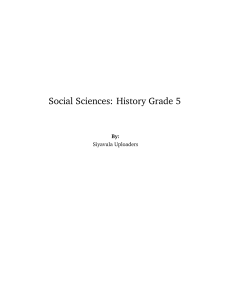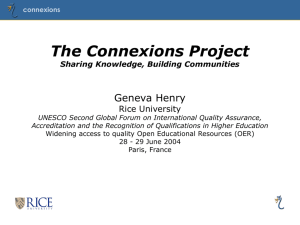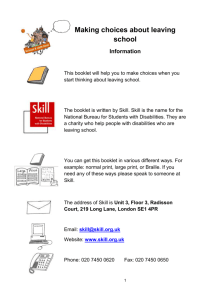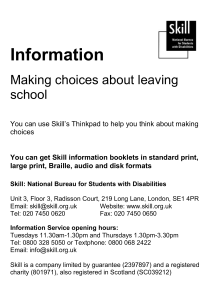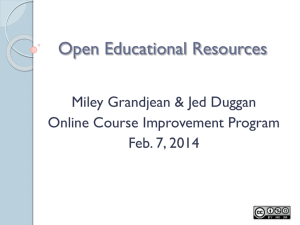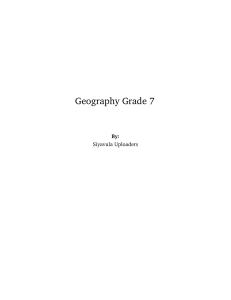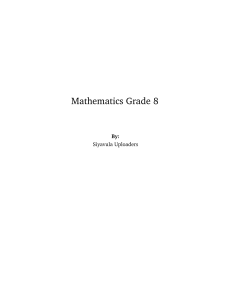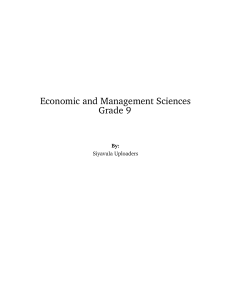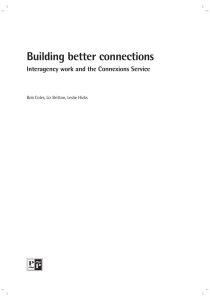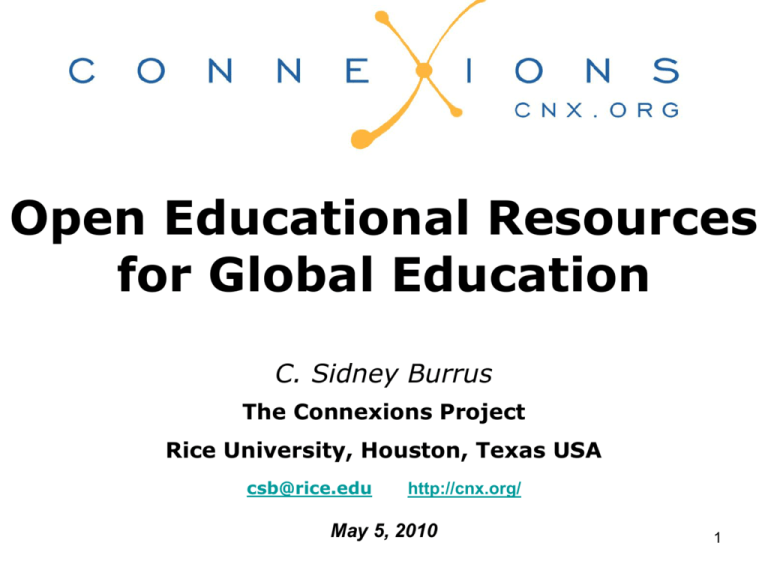
Open Educational Resources
for Global Education
C. Sidney Burrus
The Connexions Project
Rice University, Houston, Texas USA
csb@rice.edu
http://cnx.org/
May 5, 2010
1
Disruptive Technologies
Disruptive technologies change the world in
two phases:
1. The new technology first does what the old
technology did, only better. Results are
often “Intended Consequences”
2. The new technology then redefines the
problem, asks new questions that were not
possible in the first phase. Where
surprising innovation is observed.
Results often “Unintended Consequences”
2
Two Phases of the Web
• Web 1.0: HTML, presentation (looks and
layout), hypertext links, searchable, two
dimensional. Contains shared data and
information. Readable by educated people
(like a book).
• Web 2.0: XML, presentation and content,
meta-data, smart hypertext links, smart
searchable, three dimensional. Contains data,
information, and some knowledge! Readable
by literate people and by some machines.
3
Open Educational Resources
The Open Educational Resource (OER)
movement was inspired by the Open Source
movement in software. Information is freely
usable, re-usable , mixable, modifiable, etc.
•
•
•
•
•
Open Course Ware “OCW” (MIT)
Connexions “Cnx” (Rice)
Wikipedia (Wikibooks, etc.)
Siyavula project (Shuttleworth Foundation)
Curriki, PLoS, PubMed, EOL, etc.
4
What is Connexions?
1. A repository of modules of information
available through the web on the Internet
• Modules (and collections) encoded in XML, one
concept, a few pages, a quantum of information
2. A set of tools for authoring, maintaining and
using the content of the repository
• Module editor, importer, course or book composer,
repository organizer, Creative Commons license,
tools for printing books
3. A community of people who share educational
interests and information
• Interest groups (authors, instructors, students),
5
Author
s
Ideas,
information
Module
Instructors
Students
Commons or
Repository
Course,
book
6
Modular Structure of Connexions
• The module contains a stand-alone concept.
It is a quantum of knowledge.
• The module should make sense if found by a
search engine such as Google or Bing.
• A collection or book is a coherent collection
of modules.
• Analogy with a CD as being a collection of
songs, or a play-list for a band or MP3 player,
or a concert program, or an anthology
• Analogy with the degree requirements for a
major at a university
7
Books and On-Line Use with XML
Books from Connexions:
• Personalized, on-demand printing, up-to-date,
inexpensive, collaboratively authored, allows
pre and post publication review, never “out of
print”, “Long tail” publications, content for
eBooks, one button to buy printed book
On-Line use of Connexions:
• Allows modern pedagogy: concept-based,
problem solving-based, discovery-based
learning. Dynamic, interactive, linked, adapts to
learning style, student and author driven, allows
“assessment and evaluation”, Virtual Labs 8
Possible Ways to Use
• Bound and printed paper books that look
like traditional books but are low cost and
always up-to-date. This is phase one.
• Down Loadable pfd files which are free
and can be used on a eBook reader or
printed locally. This is also phase one.
• Free, interactive, dynamic on-line use on a
screen such as a computer or hand-held
device (iPad or iPhone). This is phase two!
• New methods that we cannot imagine now.
9
This is the definition of phase two.
Create, Author
stanford
illinois
michigan
wisconsin
berkeley
ohio state
ga tech
utep
rice
cambridge
South Africa
Vietman
Macedonia
10
Author of Music Content
Catherine Schmidt-Jones
well over 600,000 page views
per month
many by
US K-12
teachers
11
12
Vietnam opencourseware
MOET
13
Connexions in Spanish
DSPanish
14
15
Non-English Modules
16
Language of Modules & Collections
•
•
•
•
•
•
•
•
•
•
English
13,300
Vietnamese
655
Afrikaans
331
Spanish
320
Macedonian
54
Chinese
34
Italian
26
Ukrainian
25
Japanese
22
Portuguese
20
607
163
28
39
7
5
3
2
3
6
17
Interactive, Dynamic Virtual Lab
18
Multimedia
19
Educational Paradox
From: Inside Higher Education, Jan. 3, 2008
“It’s the central paradox of 21st-century
college students: Despite embracing
radically new ways of communicating with
each other and learning about the world,
they still remain wedded to the oldfashioned, paper-bound textbook.”
20
The Traditional Book
The book is the central tool or technology in
education at all levels and for all aspects.
The book is a mature technology that is not
improving. It and the supporting infrastructure
are the answer to the educational questions of
the 19th century, maybe the first part of the 20th
century. They are now the “bottle neck” or
“barrier”. They are no longer the answer, they
are the problem
Think about the Kindle, iPad or even the iPhone
21
Global use of Connexions
Possible tool to respond to the challenges of
the present and future in education
• Training and education of the workforce for
the 21st century and the global economy
(put PASI papers in Connexions)
• Becoming part of an international
community using a global standard
technology in both Higher Education and
general education. Not fragmented.
22
Global use of Connexions
• Allows progressive teaching techniques
(from modern learning theory) at all levels
and in all disciplines.
• Leap-frogs old educational methods and
jumps into the future (the way cell phones
are doing). Connexions is currently being
used in US, Europe, Asia. Allows scaling.
• Produce high quality, accessible educational
content in most of the world’s languages.
23
Global use of Connexions
• Supports traditional class rooms,
distance education, virtual labs, self
learning, teacher training
• Use of “unicode” allows the rendering of
virtually all the world’s alphabets. We
need work on including Arabic
• Makes education accessible to all. Is
sustainable, is scalable
24
Two Global References
1. C. S. Burrus, R. G. Baraniuk, J. P. Frantz, and
C. Holmes, “Connexions: Sharing Knowledge
and Building Communities for Global
Education”, ASEE International Colloquium on
Engineering Education, Beijing, China, 2004.
2. C. Sidney Burrus, “The Impact of OER, Web
2.0, and XML on Education”, plenary lecture
at the conference on Information and
Management Sciences (IMS-2008), Urumqi,
China, 2008
25
Two More Global References
1. Ricardo F. von Borries, Richard G. Baraniuk,
C. Sidney Burrus, and B. Flores, “DSPanish:
OER for Engineering in Spanish”, Engineering
Education in the Americas and Beyond, Rio
de Janeiro, October 9-12, 2006.
2. Sidney Burrus, D. Marcek, Ricardo von
Borries, and Richard Baraniuk, “An OER for
the Americas”, the Latin American and
Caribbean Consortium of Engineering
Institutions (LACCEI) conference. Tampico
26
Mexico, May 29-31, 2007.
What is new since 2008?
• Growth in the number of modules in the
repository from 6,200 to 16,262.
Growing exponentially!
• Input content directly, from MS Word, or
from LaTeX
• Peer-review using Lenses
• Better mathML input and display
• Global use greatly increased
• Can down-load book pdf free, or
purchase bound book at low cost
27
eXtendable Markup Language
XML can also be thought of as “X” being an
unknown that can be defined:
• mathML
x3 + 7x2 – 2x + 1 = 0
• chemistryML
H 2O
• musicML
(a music score)
• “whatever you are teaching”ML
where the rules of your subject define the
markup language. The language
“understands” your subject!!
28
The XMLs use semantic “tags” and meta-data
ecosystem – primordial state
29
30
personalize
31
reuse
32
Selected Partners
Shuttleworth
Foundation’s
Siyavula proj.
Foothill-De Anza
Community College
33
Peer Review
Connexions:
inclusive
open-contribution policy
how to find high quality materials?
what is quality? who decides? who is the
expert?
Post-publication review rather than (or in
addition to) pre-publication review system
wikipedia, bloggers
poster sessions at a conference
IEEE Signal Processing Soc project in Open
Educational Resources is with Connexions
34
Lenses
social software for peer review
inspiration: Flickr, de.licio.us, …
Rice University
IEEE.org/cnx
PASI
35
The Connexions System
36
Quality Assurance
Connexions lenses for peer review and quality control.
37
Alternative Copyright Licenses
Traditional “All rights reserved” copyright
inhibits collaboration and sometimes inhibits
creativity and innovation. Putting content in
the Public Domain is not easy.
• Creative Commons “Some rights reserved”
copyright (Larry Lessig, James Boyle)
• General Public License “GPL” (Richard
Stallman) and the GNU project
• Copyleft, Share alike, etc.
38
Usage
Current State
Repository: 16,262 modules, 20,000 revisions, 994
courses or books, over 10,000 author accounts,
147 countries, over 200 print-on-demand books
In Sept. 2006: 17M hits, 1.2M pages views, 520K
unique users from 157 countries
Globalization
Europe: Germany, Norway, Macedonia, France, etc.
Asia: China, India, Pakistan, Japan, Vietnam, etc
LACCEI: “Connexions in the Americas” project
39
Current State
Tools
Import: LaTeX converter, Word converter, inplace editor, etc
Dynamic, Interactive: Labview player in use,
talking with Wolfram, Integre, etc. Flash,
Java, jpeg, etc.
User Environment: Basic but improving.
40
Growth of Numbers of Modules
41
Exponential Growth
If people involved with Connections
in some way cause other people
to become involved and they, in
turn, cause still other people to
become involved, the growth is
exponential and the spread is
called "viral". This is what
success on the Internet looks like.
42
Exponential Growth
A graph of the logarithm of the number
of modules would be linear if the
growth itself is exponential
43
Log Plot of Numbers of Modules
44
Growth of Numbers of Collections
45
Growth of Numbers of Authors
46
The Connexions Project was started at Rice
University in 1999, but now is global and
one of the most used OERs worldwide.
An invitation to you and your university
If you are interested in being involved in
Connexions, see http://cnx.org/ or contact:
47
csb@rice.edu

